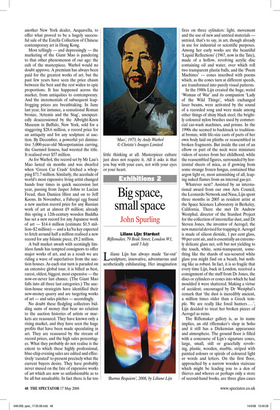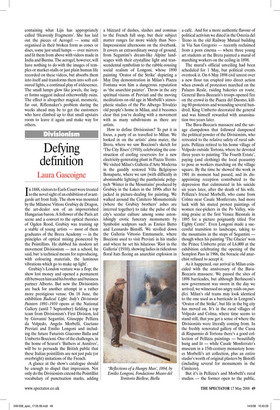Big space, small space
John Spurling
Liliane Lijn: Stardust Riflemaker, 79 Beak Street, London W1, until 5 July
Liliane Lijn has always made ‘far-out’ sculpture, innovative, adventurous and aesthetically exhilarating. Her imagination fires on three cylinders: light, movement and the use of new and untried materials — untried, that’s to say, in art, though already in use for industrial or scientific purposes. Among her early works are the beautiful ‘Liquid Reflections’ (1967, now in the Tate), made of a hollow, revolving acrylic disc containing oil and water, over which roll two transparent plastic balls, and the ‘Poem Machines’ — cones inscribed with poems which, as the cones turn at different speeds, are transformed into purely visual patterns.
In the 1980s Lijn created the huge, weird ‘Woman of War’ and its companion ‘Lady of the Wild Things’, which exchanged laser beams, were activated by the sound of a recorded song and were made among other things of shiny black steel, the brightly coloured nylon brushes used by commercial car-wash machines, and prisms. In the 1990s she seemed to backtrack to traditional bronze, with life-size casts of parts of her own body laid on plinths or reassembled in broken fragments. But inside the cast of an elbow or part of the neck were miniature videos of scenes from her childhood, while the reassembled figures, surrounded by horizontal sheets of mica, as if growing from some strange frozen fungus, contained blue argon light or, most astonishing of all, leaping naked flames from an internal gas-jet.
Whatever next? Assisted by an international award from our own Arts Council, the Leonardo Network and Nasa, Lijn spent three months in 2005 as resident artist at the Space Sciences Laboratory in Berkeley, California. There she met Dr Andrew Westphal, director of the Stardust Project for the collection of interstellar dust, and Dr Steven Jones, the inventor of Aerogel, the new material devised for trapping it. Aerogel is made of silicon dioxide, 1 per cent glass, 99 per cent air, and is essentially an extremely delicate glass net, soft but not yielding to the touch, white, semi-transparent, something like the shards of sea-scoured white glass you might find on a beach, but nothing like as robust. In fact, it is so fragile that every time Lijn, back in London, received a consignment of the stuff from Dr Jones, the discs or cylinders or cones into which he had moulded it were shattered. Making a virtue of accident, encouraged by Dr Westphal’s remark that ‘the dust is incredibly ancient, a million times older than a Greek temple. We are really like fossil hunters ... ’, Lijn decided to treat her broken pieces of Aerogel as ruins.
The Riflemaker gallery is, as its name implies, an old riflemaker’s shop in Soho and it still has a Dickensian appearance and atmosphere. The ground floor is filled with a concourse of Lijn’s signature cones, large, small, still or gracefully revolving, plastic, wooden, marble, striped with painted colours or spirals of coloured light or words and letters. On the first floor, approached by a narrow wooden staircase which might be leading you to a den of thieves and whores or perhaps only a store of second-hand books, are three glass cases containing what Lijn has appropriately called ‘Heavenly Fragments’. She has laid out the pieces of Aerogel — some still organised in their broken form as cones or discs, some just small lumps — over mirrors and lit them from above with videos made in India and Burma. The aerogel, however, will have nothing to do with the images of temples or market-stalls or just plain human life recorded on these videos, but absorbs them into itself and transforms them into soft coloured lights, a continual play of iridescence. The small lumps glow like jewels, the larger forms suggest indeed otherworldly ruins. The effect is altogether magical, mesmeric, far out. Riflemaker’s problem during the weeks ahead may be to get the customers who have climbed up to that small upstairs room to leave it again and make way for others.











































































 Previous page
Previous page